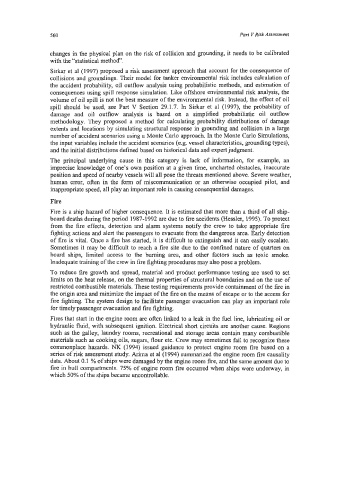Page 584 - Marine Structural Design
P. 584
560 Part V Risk Assessment
changes in the physical plan on the risk of collision and grounding, it needs to be calibrated
with the “statistical method”.
Sirkar et a1 (1997) proposed a risk assessment approach that account for the consequence of
collisions and groundings. Their model for tanker environmental risk includes calculation of
the accident probability, oil outflow analysis using probabilistic methods, and estimation of
consequences using spill response simulation. Like offshore environmental risk analysis, the
volume of oil spill is not the best measure of the environmental risk. Instead, the effect of oil
spill should be used, see Part V Section 29.1.7. In Sirkar et a1 (1997), the probability of
damage and oil outflow analysis is based on a simplified probabilistic oil outflow
methodology. They proposed a method for calculating probability distributions of damage
extents and locations by simulating structural response in grounding and collision in a large
number of accident scenarios using a Monte Carlo approach. In the Monte Carlo Simulations,
the input variables include the accident scenarios (e.g. vessel characteristics, grounding types),
and the initial distributions defined based on historical data and expert judgment.
The principal underlying cause in this category is lack of information, for example, an
imprecise knowledge of one’s own position at a given time, uncharted obstacles, inaccurate
position and speed of nearby vessels will all pose the threats mentioned above. Severe weather,
human error, often in the form of miscommunication or an otherwise occupied pilot, and
inappropriate speed, a11 play an important role in causing consequential damages.
Fire
Fire is a ship hazard of higher consequence. It is estimated that more than a third of all ship-
board deaths during the period 1987-1992 are due to fire accidents (Hessler, 1995). To protect
from the fire effects, detection and alarm systems notify the crew to take appropriate fire
fighting actions and alert the passengers to evacuate from the dangerous area. Early detection
of fire is vital. Once a fire has started, it is difficult to extinguish and it can easily escalate.
Sometimes it may be difficult to reach a fire site due to the confined nature of quarters on
board ships, limited access to the burning area, and other factors such as toxic smoke.
Inadequate training of the crew in fire fighting procedures may also pose a problem.
To reduce fire growth and spread, material and product performance testing are used to set
limits on the heat release, on the thermal properties of structural boundaries and on the use of
restricted combustible materials. These testing requirements provide containment of the fire in
the origin area and minimize the impact of the fire on the means of escape or to the access for
fire fighting. The system design to facilitate passenger evacuation can play an important role
for timely passenger evacuation and fire fighting.
Fires that start in the engine room are often linked to a leak in the fuel line, lubricating oil or
hydraulic fluid, with subsequent ignition. Electrical short circuits are another cause. Regions
such as the galley, laundry rooms, recreational and storage areas contain many combustible
materials such as cooking oils, sugars, flour etc. Crew may sometimes fail to recognize these
commonplace hazards. NK (1994) issued guidance to protect engine room fire based on a
series of risk assessment study. Arima et a1 (1994) summarized the engine room fire causality
data. About 0.1 YO of ships were damaged by the engine room fire, and the same amount due to
fire in hull compartments. 75% of engine room fire occurred when ships were underway, in
which 50% of the ships became uncontrollable.

